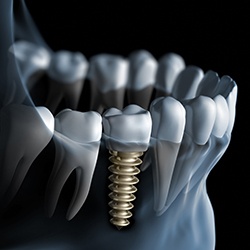
Dental Implants Improve Sagamore Hills Smiles
 Dental implant procedures have become very commonplace in today’s dental practices. There are multiple applications for dental implants. This article will review some of the methods how dental implants are used. Dental implants are made of surgical grade titanium and are biocompatible, and they can be used to create esthetic and natural feeling restorations.
Dental implant procedures have become very commonplace in today’s dental practices. There are multiple applications for dental implants. This article will review some of the methods how dental implants are used. Dental implants are made of surgical grade titanium and are biocompatible, and they can be used to create esthetic and natural feeling restorations.
To understand how a dental implant works, let’s first talk about your natural teeth. For simplicity, we can break down a tooth into two parts. The first part is the crown. The crown of the tooth is what you see when you smile or talk. The second part of the tooth is the root. The root is under the gum line surrounded by bone. A dental implant is basically a root replacement. The implant can be used to replace single or multiple teeth.
Let’s look at some different scenarios where we can use dental implants:
Our first patient has fractured a molar and the tooth has to be extracted. After reviewing replacement options with the patient, they have decided to replace their tooth with an implant. They will then have the tooth extracted, and the implant may or may not be placed at the time of extraction. If the implant cannot be placed immediately, then a bone graft will be placed in the extraction site to preserve the bone.
Once the graft has healed, the implant will be placed into the bone and allowed to integrate. “Integrate” means that the bone cells will grow and fuse to the implant, essentially holding the implant in place. Now, our implant is ready to have a crown attached to it. The crown is typically attached to the implant with an abutment. The final result looks and feels just like a real tooth.
Our second patient has neglected their mouth for several decades. They have many missing teeth, several cavities, and severe periodontal disease. After discussing treatment options with them, they have decided to extract their remaining teeth and fabricate an implant-retained denture. Yes, implants can also be used to hold dentures in place securely. This is usually necessary for the lower arch where a patient may not have enough bone to hold a traditional denture in place. Conventional lower dentures typically float around to some degree. This can make eating and speaking very difficult at times.
Implant dentistry has changed this. Our patient can have the necessary extractions completed, two to four implants can be placed into the jawbone, and a denture can be made that will be stabilized by the implants. The end result is a denture that is secure and functions well for the patient.
Above are just two examples of how implants are used in dentistry today. Implants can also be used to hold bridges and partial dentures as well.
All in all, dental implants offer a conservative and predictable solution for many dental problems.